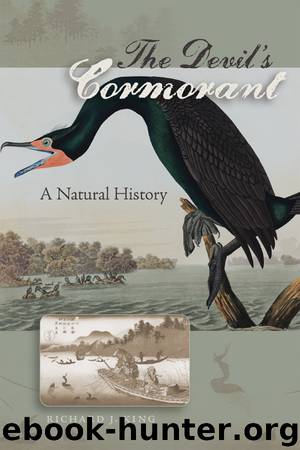The Devil's Cormorant by Richard J. King

Author:Richard J. King
Language: eng
Format: epub
Publisher: University of New Hampshire Press
Since these cormorants were nesting in the Florida Keys, we know they belong to what wildlife managers now call the Southern population of double-crested cormorants, a subspecies (P. auritus floridanus). Audubon thought of them as their own species, which he painted in an open-gaped, distressed posture, and called the “Florida Cormorant.” (See cover.)
Like most naturalists up through the mid-twentieth-century era of Niall Rankin, Audubon sampled his birds not only with his gun, but also openly with his palate. Cormorants did not have a reputation as good food for European colonists or their descendants in North America. I’ve found no epicurean rhapsodies about cormorant dinners like those from the explorers and adventurers of the Antarctic. On the other hand, Native Americans on both coasts seem to have been quite fond of eating cormorant. In Monterey, California, for example, the Ohlone Indians particularly enjoyed cormorant eggs and chicks.18
Audubon mentioned the cormorant as food a few times, although he never tried it himself. He heard the meat was tough, dark, and fishy. The Floridian Native Americans and local African Americans killed young cormorants and preserved them with salt. In New Orleans Audubon observed young salted cormorant for sale in the market, bought by “the poorer people” to make “gombo soup.”19 When up in Nova Scotia he found that the men would not take the cormorant eggs because they were inedible, but they would eat young cormorant salted. “I have never eaten Cormorant’s flesh,” Audubon wrote. “And intend to refrain from tasting it until nothing better can be procured.”20
A few decades later, ornithologist Oliver Austin wrote in his survey of the birds of Labrador: “Not only is [double-crested cormorant] flesh too rank, tough, oily, and fishy for eating, but its filthy nesting habits and its unappetizing appearance have long eliminated it as a possible food bird, even among unparticular and half-starving peoples.”21
Occasionally as I have listened to ideas on how to resolve some of the human-cormorant conflicts in the United States or Europe, I’ve thought that if some people ate cormorant, then the culling or proposed hunting programs would be easier to take. There could be similarities to the management strategies with Canada geese.22
During my visit to Belzoni I went out driving with Brady Thompson, a farmworker who was “running birds” in one of the white trucks. He said no one eats cormorant in the Delta. Steeby and all the catfish farmers scoffed at the idea of eating this bird.
One farmer named Larry Brown told me a story about one of his men a few years back: “He would eat anything. Coot. Raccoon. Anything. One time he took home a cormorant and cooked it up. He came back the next day and said ‘Taste kind of strong.’ Now if he said that, then cormorant must be inedible.”23
Once I was teaching college students on a tall ship sailing out of Key West. On a late January afternoon we were out in the middle of the Florida Straits. I was writing up at the bow, minding my own business, when a cormorant landed on some rope right over my head.
Download
This site does not store any files on its server. We only index and link to content provided by other sites. Please contact the content providers to delete copyright contents if any and email us, we'll remove relevant links or contents immediately.
The Lonely City by Olivia Laing(4772)
Animal Frequency by Melissa Alvarez(4430)
All Creatures Great and Small by James Herriot(4277)
Walking by Henry David Thoreau(3926)
Exit West by Mohsin Hamid(3796)
Origin Story: A Big History of Everything by David Christian(3666)
COSMOS by Carl Sagan(3592)
How to Read Water: Clues and Patterns from Puddles to the Sea (Natural Navigation) by Tristan Gooley(3434)
Hedgerow by John Wright(3319)
How to Read Nature by Tristan Gooley(3294)
The Inner Life of Animals by Peter Wohlleben(3286)
How to Do Nothing by Jenny Odell(3265)
Project Animal Farm: An Accidental Journey into the Secret World of Farming and the Truth About Our Food by Sonia Faruqi(3192)
Origin Story by David Christian(3170)
Water by Ian Miller(3157)
A Forest Journey by John Perlin(3044)
The Plant Messiah by Carlos Magdalena(2900)
A Wilder Time by William E. Glassley(2837)
Forests: A Very Short Introduction by Jaboury Ghazoul(2815)
